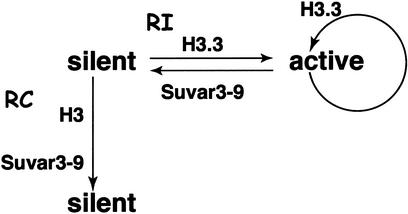Figure 7.
RI deposition allows switching of heritable chromatin states. Nucleosomes in silent heterochromatin are distinctively modified by methylation, and thereby recruit the HMT Suvar3-9. The silencing epitope can be perpetuated by Suvar3-9 through the cell cycle by the methylation of H3 after replication-coupled deposition (vertical arrow). A gene can be activated (rightward arrow) at any time in the cell cycle, and the unraveling of methylated nucleosomes and RI deposition of H3.3 will remove the silencing epitope. This abolishes Suvar3-9 recruitment and allows stable activation. RI deposition of H3.3 will continue as long as the gene is transcribed. Switching from an active to a silent state (leftward arrow) can occur by repressing transcription and methylating the N-terminal tail of H3.3 at Lys-9, once again recruiting the Suvar3-9 complex.

